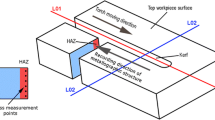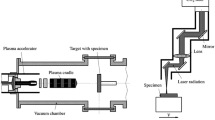Abstract
Treatment of the cutting tool with a low-temperature plasma gas discharge formed by the interaction of microwave electromagnetic and electrostatic fields directly around the working part ensures its hardening by changing the values of the parameters that characterize the physical–mechanical and electrophysical properties of the surface layer. This contributes to the prolonged tool life, and results in the improved machinability of materials by cutting according to the criterion of productivity increase. The article presents a study aimed at establishing the rationale leading to such results.









Similar content being viewed by others
Data availability
Unavailable.
Code availability
Unavailable.
References
Grigor’ev SN, Gribkov AA, Zakharchenko DV (2013) Global trends in machine-tool design. Russ Eng Res 33(8):468–470
Zarubin SG, Deev KA (2017) Process model of digital manufacturing. Russ Eng Res 37(8):714–719
Lyutov AG, Ryabov YV (2016) Automatic control of manufacturing processes: a model. Russian Eng Res 36(11):934–939
Kokorev DS, Yurin AA (2019) Digital twins: concept, types and benefits for business. Colloq-J 10(34):31–35 (RUS)
Bolotov MA, Dmitriev VN, Pronichev ND et al (2010) High-speed and high-performance processing (modes, characteristics of machine tools, tools): electronic guidelines. 88 p. Samara: Samara State Aerospace University (RUS)
Plotnikov AL (2012) Control of the process parameters of blade processing on CNC machines: monograph; Sc. Ed. A.P. Babichev; VolgGTU. 231 p. Tolyatti: ZAO "ONIKS" (Series: Quality Management of Technological Processes in Mechanical Engineering / Gen. Ed. Yu.M. Solomentsev) (RUS)
Chukwuneke JL, Izuka CO, Omenyi SN (2019) S-domain stability analysis of a turning tool with process damping. Heliyon 5:e01906
Pangestu P, Pujiyanto E (2021) Cucuk Nur Rosyidi Multi-objective cutting parameter optimization model of multi-pass turning in CNC machines for sustainable manufacturing. Heliyon 7:e06043
Yu A (2009) Markar’yan Active monitoring of drill wear in cutting. Russian Eng Res 29(4):400–403
Solonenko VG, Solonenko LA, Dvadenko IV et al (2007) Improving the quality of the cutting tool. STIN 7:12–16 (RUS)
Chen S-H, Ho Y-L (2019) Lifespan of super-alloy Waspaloy cutting tools. Heliyon 5:e01388
Vereshchaka AS, Kirillov AK, Sotova ES, Dacheva AV (2010) High-strength ceramic composite with nanostructural coating in environmentally benign dry cutting with compensation of lubricant properties. Russ Eng Res 30(9):959–963
Pegashkin VF, Pegashkina EV, Pishchevskaya ES (2017) Mathematical model of cutting tool durability under conditions of fuzzy sets. Vestnik Mashinostroeniya 2:70–72 (RUS)
Zoriktuev VY, Nikitin YA, Sidorov AS (2007) Monitoring and prediction of cutting tool wear. STIN 10:31–34 (RUS)
Alves SM, Albano W, de Oliveira AJ (2017) Improvement of coating adhesion on cemented carbide tools by plasma etching. J Braz Soc Mech Sci Eng 39(3):845–856
Migranov MS, Makhmutova AS (2007) Wear resistance and tribological properties of cutting tool coatings. Vestnik Mashinostroeniya 11:43–46 (RUS)
Vereshchaka AS, Tretyakov IP (1986) Cutting tools with wear-resistant coatings. 192 p. Moscow: Mashinostroenie (RUS)
Mokritskii BY (2011) Control of tool performance by means of coatings. Russ Eng Res 31(2):164–167
Kirsanov SV, Goncharenko IM, Babaev AS (2013) Influence of “dry” polishing of hard-alloy samples on the characteristics of wear-resistant coating, Reference book. Eng J 4:12–15 (RUS)
Tabakov VP (1998) Performance of cutting tools with wear-resistant coatings based on complex titanium nitrides and carbonitrides. 123 pp, Ulyanovsk: UlGTU (RUS)
Tabakov VP, Chikhranov AV (2010) Influence of the composition of three-element nitride coatings on the state and wear of a cutting tool. Russ Eng Res 30(1):84–89
Talantov NV (1992) Physical foundations of the process of cutting, wear and destruction of the tool. 240 pp. Moscow: Mashinostroenie (RUS)
Mokritskii BY , Dzyuba AK (2013) Model and mechanisms of destruction of coated hard-alloy tool materials. Metalworking 2:46–53 (RUS)
Vereshchaka AS, Lytkin DN (2017) Influence of the substrate on the performance of a coated cutting tool. Metalworking 1:23–28 (RUS)
Brover GI, Shulga AA, PRusin PI (1989) Features of laser and electron beam processing of tool steels. Electron Process Mater 1(151):15–18 (RUS)
Satyanarayana T, Rao PS, Krishna MG (2019) Influence of wear parameters on friction performance of A356 aluminum — graphite/granite particles reinforced metal matrix hybrid composites. Heliyon 5:e01770
Latyshev VN, Naumov AG, Novikov VV et al (2005) Improving the durability of a high-speed tool by ion-laser surface hardening. Mach Tool 6:17–20 (RUS)
Sheleg VK, Zhigalov AN, Bogdan DD (2020) Study of the effect of aerodynamic sound hardening on the wear of metal-cutting hard-alloy coated inserts. Sci Technol 19(4): 271–279 (RUS)
Aleksandrov VA, Petrova LG, Sergeeva AS, Aleksandrov VD, Akhmetzhanova EU (2019) Production of tool coatings by chemicothermal plasma methods. Russ Eng Res 39(8):693–695
Shastin VI, Konovalov NP (2016) Technological support for the processes of laser modification of surfaces of structural alloys. 163 p. Irkutsk: Irkutsk National Research Technical University (RUS)
Martynov VV, Brzhozovskii BM, Azikov NS, Brovkova MB, Zinina EP (2021) Low-temperature plasma technique for skin structure consolidation. Int J Adv Manuf Technol 117(7–8):2387–2394
Brzhozovskii BM, Bekrenev NV, Martynov VV, Zinina EP (2016) Increase in the efficiency of ultrasonic processing of components made of brittle materials. J Mach Manuf Reliab 45(6):554–561
Kelly A, and Groves GW (1970) Crystallography and crystal defects. 428 p. London: London Longman Group Ltd
Bragg WL, Claringbull GF (1965) Crystal structures of minerals. 409 p. London: G. Bell and Sons Ltd
Yuriev YN, Mikhnevich KS, Krivobokov VP et al (2014) Properties of titanium nitride films obtained by magnetron sputtering. Proceed Samara Sci Center Russian Acad Sci 16 4(3):672–676 (RUS)
Vasiliev VV, Luchaninov AA, Reshetnyak EN et al (2009) Structure and hardness of Ti-N- and Ti-Si-N-coatings deposited from filtered vacuum-arc plasma. Issues Atomic Sci Technol 2:173–180 (Series: Physics of Radiation Damage and Radiation Materials Science (93)) (RUS)
Zhuravleva PL, Treninkova IA, Sbitneva SV et al (2010) Study of the structure of single layer TiN coatings and multilayer TiN/ZrN coatings. Russian Nanotechnol 5(9–10):112–116 (RUS)
Savitsky EM, Burov MV (1978) Electrical and emission properties of alloys. 294 p. Moscow: Nauka (RUS)
Berman R (1976) Thermal conductivity in solids. 193 p. Oxford: Clarendon Press
Epifanov GI (1977) Solid state physics: textbook. 288 p. Moscow: Vysshaya shkola (RUS)
Ryzhkin AA (2005) Thermophysical processes during wear of tool cutting materials. 311 p. Rostov-on-Don: DSTU Publishing Center (RUS)
Bolshakov AA, Karimov RN (2007) Methods for processing multidimensional data and time series: textbook. 522 pp. Moscow: Goryachaya Liniya - Telecom (RUS)
Funding
This study was supported by Russian Science Foundation (Project No. 19-19-00101).
Author information
Authors and Affiliations
Contributions
Boris Brzhozovsky substantiated the approach to the study.
Elena Zinina carried out low-temperature plasma hardening of the inserts; measured the parameters of the physical–mechanical and electrophysical properties of their surface layer before, after hardening, and after production tests; and processed the diffraction patterns.
Vladimir Martynov performed the analysis of diffraction patterns and the results of production tests of inserts.
Vladimir Tabakov presented coated inserts and diffraction patterns of their surfaces.
Corresponding author
Ethics declarations
Conflict of interest
The authors declare no competing interests.
Additional information
Publisher's note
Springer Nature remains neutral with regard to jurisdictional claims in published maps and institutional affiliations.
Rights and permissions
Springer Nature or its licensor (e.g. a society or other partner) holds exclusive rights to this article under a publishing agreement with the author(s) or other rightsholder(s); author self-archiving of the accepted manuscript version of this article is solely governed by the terms of such publishing agreement and applicable law.
About this article
Cite this article
Brzhozovskii, B., Zinina, E., Martynov, V. et al. Low-temperature plasma hardening impact on the properties of the surface layer of the cutting tool working part. Int J Adv Manuf Technol 124, 183–195 (2023). https://doi.org/10.1007/s00170-022-10465-z
Received:
Accepted:
Published:
Issue Date:
DOI: https://doi.org/10.1007/s00170-022-10465-z




